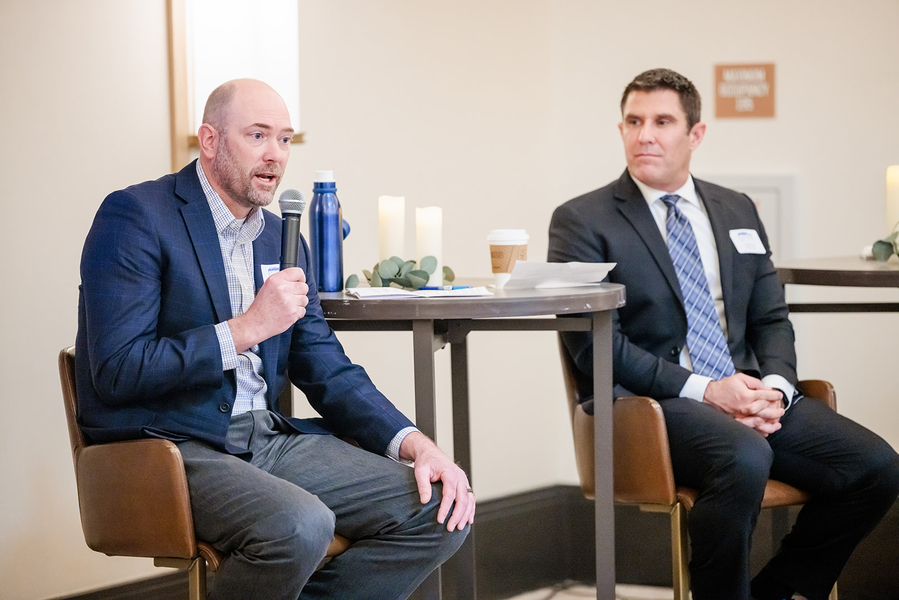It has become more challenging, and more expensive, to secure water for development along Colorado’s Front Range — and water makes up a significant percent of the cost of new homes.
Those were some of the themes expressed at BusinessDen’s “The Future of Water & Development” event on Feb. 26, which was sponsored by Pless Law and explored a component of development that much of the country doesn’t have to think about.
“People don’t understand the differences in the way Colorado’s water rights are structured as opposed to other states and in most states,” Pless Law founder Justin Pless said. “If you live next to a body of water, you have the right to take water out of that lake or stream. In Colorado. It’s not that way. That water is owned by somebody else.”
Max Gansline, vice president of leasing for The Staenberg Group, noted that the Missouri-based retail real estate firm has developed in 20 states.
“Colorado is the only state where we have a box on our due diligence form that says, ‘Is there water – yes or no?’ And that should tell you a lot about how unique it is to develop and operate in this community,” he said.
In some cases, where municipalities already have enough water to support growth, developers can simply pay a “tap fee” to get the needed water for the project. But developers also often find themselves needed to secure water themselves, then dedicate it to a municipality before they can build.
“Outside of Denver and some of the large municipalities, things are quite balkanized. There’s a wide variety of policies and dedication requirements,” said Walraven Ketellapper, a water broker and the founder of Stillwater Resources.
Among The Staenberg Group’s projects is the City Centre project in Firestone. The firm developed the first phase of the retail complex in the late 2000s by buying Colorado-Big Thompson shares, which has historically been the easiest way to secure water in northern Colorado. But the price of the shares has skyrocketed in the past two decades — an auction earlier this month saw an average price of $52,000 — and, with more shares being held by municipalities, there are fewer opportunities to purchase them.
Gansline said that, as The Staenberg Group began planning for a second phase of the project recently, buying the necessary shares was no longer economically feasible — so the company and the growing town eventually struck a deal.
As part of the redevelopment agreement, the city agreed it would take care of securing the necessary water, in exchange for a sizable say about the makeup of the second phase.
“It puts the town at the seat at the table to be able to basically restrict what we do to pick tenants, to exclude certain types of tenants. So we can’t have huge water users, for example, car washes. We can’t have a certain number of tenants — more than two — that don’t generate sales tax, because the city wants to see sales tax,” Gansline said. “So we’re willing to agree to that in exchange for them providing water for our use.”
Tim Craft is head of Craft Cos., which plans and undertakes infrastructure work for new residential communities. The cost to get water can run six figures per home, he said.
“For a single-family home we typically assume about $100,000 for the resource, the taps and then the infrastructure to connect,” Craft said. “So that’s before you buy the land, before you start digging the foundation.”
Craft noted that cost comes early in a project, meaning his firm might have to carry that cost for seven years on a larger project.
“So obviously that has a material impact on the cost of our homes,” he said.
Pless said purchasing credits through water banks can sometimes work for smaller projects. Some communities are also open to creative solutions.
“We did a development there (in Fort Collins) a couple of years back where we were able to secure a long-term lease of some water rights from a ditch company to use that to satisfy the water district’s non-potable requirements,” Pless said. “So we were able to sort of take some of that large up-front cost and defray it and make it an ongoing obligation that gets paid over time.”
The process of securing water in Denver itself is somewhat easier. Rick Marsicek, chief water resource strategy officer for Denver Water, noted that the organization’s service area is relatively built up already. Denver Water benefits from the fact that it was founded in 1918 and secured many sources of water decades ago.
Marsicek said the organization is “doing good from the standpoint of current supply-demand.”
“As we look into the future, very uncertain with climate change and growth,” Marsicek said. “And so we use what we call scenario planning. We look at multiple futures, multiple potential futures, varying anything from climate, population growth, supply challenges, and we plan for 50 years out … If something isn’t unfolding the way we would expect it to we have time to react.”





































